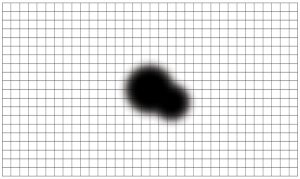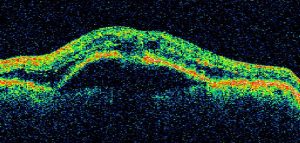How leaky blood vessels create a chronic, degenerative condition
Wet AMD (age-related macular degeneration) is a chronic, degenerative condition characterised by abnormal blood vessels that grow underneath the retina. The condition gets worse as these faulty blood vessels leak fluid in the back of the eye. This may lead to swelling and damage of the macula, the part of the retina that lets you see colour and maintain sharp vision.
A healthy retina is a dry retina. If this fluid isn’t controlled, central vision will gradually get worse, leading to difficulty doing everyday activities such as reading, recognising faces and driving1.

The leaky blood vessels are caused by an excess of a tiny protein called vascular endothelial growth factor (VEGF). Most eye doctors agree that the best way to control these tiny proteins is with an anti-VEGF treatment. Treatments that help control fluid and stop blood vessels from leaking may slow the progression of wet macular degeneration.
To monitor the progression of wet AMD your doctor may ask you to keep track of your own vision using a black and white grid called an “Amsler” grid1.

Your eye doctor may also ask you to make an appointment for an OCT scan. OCT, or optical coherence tomography, is a common, non-invasive imaging technique, similar to photography, that is used to detect fluid in the retina1.

Regular monitoring is extremely important because wet AMD can cause severe vision loss over a short period of time. Once you have wet AMD in one eye, the chances of it developing in other eye are increased1. With a chronic condition like wet macular degeneration, keeping your eye appointments is critical.
-
National Eye Institute. Facts About Age-Related Macular Degeneration. Available at https://nei.nih.gov/health/maculardegen/armd_facts (link is external). Access July 2019.
-
Arnold J et al. The role of sub-retinal fluid in determining treatment outcomes in patients with neovascular age-related macular degeneration–a phase IV randomised clinical trial with ranibizumab: the FLUID study. BMC Ophthalmol. 2016;143(4):679-680.
-
Kim R. Introduction, mechanism of action and rationale for anti-vascular endothelial growth factor drugs in age-related macular degeneration. Indian J Ophthalmol. 2007;55(6):413-415.
-
Gehrs KM, Anderson DH, Johnson LV, and Hageman GS. Age-related macular degeneration—emerging pathogenetic and therapeutic concepts. Ann Med. 2006; 38:450-471.

